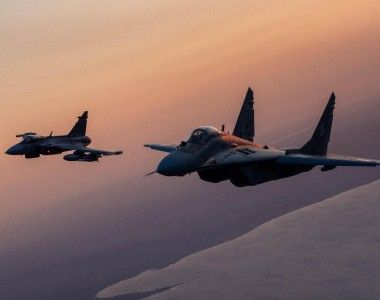Dawn of the Post-Soviet Fighters. A New Platform for the Polish Air Force? [ANALYSIS]

Photo. senior staff chor. Adam Roik / Combat camera DO RSZ
The Polish Air Force needs more than 150 combat aircraft to accomplish the tasks assigned to them. The Eurofighter consortium has been showcasing the capabilities offered by the latest Eurofighter Typhoon variant this year, at the MSPO event in Poland, and during the Farnborough International Airshow. The narrative suggested that the Typhoon may be a good choice if Poland decided to procure an air superiority platform. Aircraft as such may be a major boost in the air defence domain, also serving as a launch platform for a higher quantity of long-range weapons. The F-35 would act as the stiletto, while the Eurofighter is perceived as a heavy sword, or an axe needed to bring the enemy down.
The increased marketing activities among companies offering platforms heavier than the F-35, or the F-16, have probably been inspired by the latest statements made by Mariusz Błaszczak, head of the Polish MoD. He has been suggesting that there is a necessity to further reinforce the Polish Air Force. That reinforcement would involve the commissioning of an air superiority platform. This kind of mix of heavier and lighter platforms, working with 5th-gen fighters that can cooperate with them, with the former being able to carry more weapons, creates a potential of having a greater capability against air threats. However, a mix as such would also offer a greater payload capacity when it comes to long-range cruise missiles.
The concept is also aligned with analytical studies, concluding that Poland should have at least Multi-Role Aircraft (MRCA) at hand, to meet the allied commitments and cover its own needs. The numbers vary, from 160 to 200 platforms. It would be a logical step to use platforms with complementary capabilities. Apart from the F-35s, tasked with ISR and high-value target elimination, and the multi-role F-16s, it would also be justified to procure a heavier platform, with greater firepower.

Photo. Rafał Lesiecki/Defence24.pl.
It should be strongly emphasized, neither is that concept unique, nor new. A similar force structure is being established in the UK for instance. The United Kingdom is procuring major quantities of the F-35s, also modernizing the Eurofighter Typhoon to the latest standard, fitting them with the Captor-E Scan Mk 2 AESA radars. USAF, following a similar concept, decided to purchase the F-15EX Advanced Eagle. There are many similarities between those two, such as the modern AESA sensors, panoramic MFDs, and greater range and payload capacity.
Eurofighter's head of marketing and sales, Constantino Panvini Rosati, hailing from Leonardo, says that the European super fighter already has some major advantages over its competitors. And that set of advantages is expected to grow. Rosati points to the Eurofighter's climb rate and service ceiling, allowing the jet to quickly ascent to the desired altitude, and establish a superiority, along with the payload capacity, making it possible to overwhelm the potential adversary with missiles, staying outside of his missile, or even sensor range.
Radar as a Weapon?
Leonardo Captor-E Scan Mk 2 radar provides the Typhoon with a unique set of capabilities, stepping beyond the sheer breadth of the scan pattern, ensured by the moving AESA antenna. The radar also makes it possible to detect ECM and neutralize these assets, through selective AESA T/R module control. The radar itself also acts as a potent EW asset, as it may jam a signal in the given spectrum, coming from a specific direction.
Thanks to its jamming capability, the Eurofighter Typhoon's radar would be able to significantly reduce the effective range of the enemy radars. Not only does it pose a challenge for the adversary to detect the allied air assets, but it also has a detrimental impact on the lethality of the enemy radar-guided missiles. Selective jamming, concerning specific frequencies and direction means that the ECM employed by the Typhoon would have no impact on the capacity of the allied systems. Furthermore, this set of capabilities will make it even more challenging for the adversary to detect low-RCS assets, such as the F-35, or the JASSM missile. This somewhat is reminiscent of attempts made to hear an electric vehicle in artificial noise conditions.

Photo. Crown Copyright
Alongside those extra capabilities, the Captor-E Scan Mk 2 radar also offers a lot, when it comes to detection and tracking of multiple ground and air threats at once. It provides the pilot with AESA-specific, unique capability to detect targets within a wide angle, thanks to an electronic scanning array that also moves - vertically and horizontally, thanks to the new swivel mount. That makes it possible to detect and track enemy aircraft while maneuvering. The radar may track and lock onto the target, and launch the missiles at a much greater angle. Putting this in layman's terms, one can launch a missile against an enemy aircraft located to the side, and lower, or higher, than the Eurofighter jet. Not only is this useful in a dogfight, but it may also be an asset when using long, and medium-range missiles.
Captor-E Mk 2 also features numerous navigation and ground target tracking/engagement functions, including SAR (Synthetic Aperture Radar) mode, and functionality allowing for tracking moving targets. This makes it much easier to ID and track surface targets, designate them, and use varied weapons systems that the Eurofighter Typhoon may carry.
9 Tonnes of Deadly Payload
The Eurofighter Typhoon offers high performance when it comes to its engines, service ceiling, or speed, including the climb rate and payload figures. 13 hardpoints can be used to carry a total of 9 tonnes of varied weapons. The range of available weapons is being continuously expanded, it includes air-to-air missiles, guided bombs, gliding bombs, and a number of different PGMs.
The air-to-air arsenal primarily includes the MBDA Meteor missile, praised for its speed, range, and guidance system. These were designed from scratch to intercept highly maneuverable threats at great distances. They feature a ramjet propulsions system and an active radar guidance unit.
Right now the Typhoon can carry up to 10 Air to Air Missiles (AAMs). In the future, that number may potentially grow, if new missile rails are adopted, for mounting 2-3 missiles under a single hardpoint. This creates a potential for enhancing the Eurofighter's capability when neutralizing air threats, making the Typhoon an even more lethal air superiority platform.
As the Eurofighter consortium representatives stress, even though Typhoon is an air dominance asset by design, its latest variants, such as the one offered to Poland, can carry out CAS, deep strike, anti-ship strike, and SEAD/DEAD mission sets.
A variety of guided bomb units, Storm Shadow and Taurus cruise missiles, and Brimstone/Spear air-to-ground missiles have all been integrated on the Typhoon already. The latter are being developed across multiple domains. Apart from kinetic munitions, EW missiles, or ones that act as MRCA radar signature decoys, are also being developed. There is also a possibility to integrate other types of guided weapons on the Typhoon. A programme has been launched to integrate the AARGM anti-radiation missile on the Eurofighter. These would replace the HARM missiles - the lethality of which, when used against Russian air defences, has been recently proven in Ukraine.
Eurofighter programme Vice-President at Leonardo Aircraft, Costantino Panvini Rosati, noted that even in an air-to-ground configuration, the Typhoon still can carry 4 Meteor air-to-air missiles underneath the fuselage, where they are slightly recessed, along with 2 ASRAAM short-range AAMs. This means that the Typhoon never loses its air superiority potential, being able to engage the enemy aircraft at all times.
One should note that there are continuous efforts underway, aimed at developing the kinetic and non-kinetic Eurofighter Typhoon's capabilities. Currently, the Typhoon is advantageous, when compared to the air assets the potential adversary uses, including the Su-57, defined as a 5th generation platform by the Russians.
5th Gen. Myth?
Despite the fact that the Eurofighter Typhoon, following the American classification, shall be perceived as a 4+ generation fighter, not a 5th generation asset defined mostly by physical stealth features, that qualification is much more complex. The European fighter has a partially reduced RCS anyway, thanks to its design features. Above all, as the representatives of the Eurofighter consortium point out, the Typhoon makes use of the so-called e-stealth features. That means the jet features a broad array of passive and active EW means, making detection, ID, and lock-on a major challenge, also reducing the range of the enemy radars.
Eurofighter is also able to extend its e-stealth features, also protecting other assets, including the 5th generation platforms. These would be harder to detect because of the higher levels of background noise, and thus stealthily approaching the targets would be much easier.

When it comes to its passive sensors, datalinks, net-centric capability, and avionics, the latest Eurofighter variants are at least on par, or even superior, when compared to the allied 5th gen. assets. The Typhoon offered in Poland would feature a passive IRST, Link 16 datalink, or a modern human-aircraft interface, including a large format MFD in the cockpit, replacing multiple, but separate displays. Thanks to the above, it is possible to arrange the data on screen in a way that would respond to the mission requirements. The same data can be displayed on the helmet-mounted display with a 360-degree FOV and an ability to aggregate the data and create an impression of a transparent cockpit floor.
As the Eurofighter consortium representatives claim, not being perceived as a 5th generation platform, according to general terms, not only is the Typhoon superior when compared to 4.5 or 4++ fighters (the group it belongs to), but it also has some advantages over the 5th gen. jets. One may say then, that Typhoon is placed somewhere between the 4++, and 5+ generation assets.
Path Towards the 6th Generation and Cooperative Effort
Summing it up, one could conclude that not only is the Eurofighter Typhoon a very lethal reinforcement for the 5th generation aircraft, such as the F-35 that Poland would soon be receiving, but the Typhoon is also a platform that incorporates many solutions designed both for the European 6th generation aircraft, as well as for the whole future air combat system, also known as FCAS.

One should remember that FCAS is not just a single aircraft platform. It is a future system consisting of manned and unmanned platforms, new armament, new intelligence gathering, and datalink assets, new navigation solutions, or new ECM/EW systems. It is a comprehensive solution. Numerous elements of that system, including the MUM/T approach, would also be available to Eurofighter Typhoons - also expected to be able to work hand-in-hand with the 6th generation FCAS platform.
Notably, the Eurofighter Typhoon offer does not pertain to the platforms alone, as it would also include industrial, and research cooperation, within an international, European consortium manufacturing the jet. That consortium includes businesses from Italy, Germany, Spain, and the UK. Poland could potentially become another member, not only engaging in manufacturing and maintenance of the Eurofighter fleet, operated by all the users, but also in 6th generation MRCA programmes, and the FCAS concept, or even in other, related undertakings.
As Costantino Panvini Rosati, Vice-President for the Eurofighter Programme at Leonardo Aircraft stresses, this is a comprehensive offer addressing the needs of both the industry, as well as the armed forces. Either way, this may result in a major transfer of modern technologies, and gradual growth of capacity available domestically. One cannot walk by, without noticing the potential offered by a broad spectrum of cooperative efforts, within the European aerospace and defence programmes incorporated within the international Eurofighter consortium.



